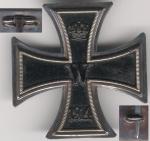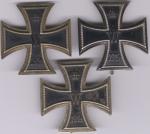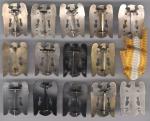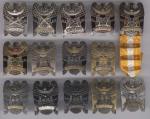
Mike K
For Deletion-
Posts
583 -
Joined
-
Last visited
Content Type
Profiles
Forums
Blogs
Gallery
Events
Store
Everything posted by Mike K
-
EK 1914 A very special Langemarck EK1
Mike K replied to webr55's topic in Germany: All Eras: The Iron Cross
Some great research on a nicely worn (early) WS marked EK1. A true piece of history! Regards Mike -
EK 1914 1914 EK1 "AWS" flatback,maker marked!
Mike K replied to Motorhead's topic in Germany: All Eras: The Iron Cross
Hi Micha, OK, now I understand re the flat-backed comment. For me as an Australian-speaking native, I think of this type of AWS as "smooth-backed". I have one like it, but it's had a hard life. Re the second one you show, from the scans my first impression was that the pin may be a replacement. First the tone/finish on the pin is different to the cross and second there appears to be some light scratching and "deformation" around the hinge and hinge-pin. I've seen several needle pin-back AWS crosses where the needle pin is missing, so an old replacement pin would not surpirse me. I can only look at scans though and you have the cross in hand of course. Regards Mike -
EK 1914 1914 EK1 "AWS" flatback,maker marked!
Mike K replied to Motorhead's topic in Germany: All Eras: The Iron Cross
Hi Micha, A nice looking example! I don't recall seeing an AWS flat-backed version before. All the ones I've seen have been vaulted, so a very interesting variant. That's the much less common stamped, rather than raised, maker mark isn't it? Regards Mike -
EK 1914 QUESTION ON 'KO' and 'WILM' MARKINGS
Mike K replied to Fariz's topic in Germany: All Eras: The Iron Cross
Hi Fariz, 1914 and 1939 EK2s were generally constructed using a central iron core and two separate frame halves (plus ring and ribbon loops of course). There are exceptions with one-piece examples and brass or zinc cored examples, etc. There are 1914EK2 fakes, however they are relatively crude and with genuine examples produced in the millions and still fairly cheap, the fakes are not really that common. Many of the earlier 1914EK2s had genuine (unmarked) silver frames and baked enamel cores, so they were good quality to begin with and can retain the blacking on their cores very well. Dealers commonly polish the patina off to make them look even better. Regards Mike -
EK 1914 QUESTION ON 'KO' and 'WILM' MARKINGS
Mike K replied to Fariz's topic in Germany: All Eras: The Iron Cross
I don't recall ever seeing an EK1 marked "WILM" - anyone got a picture of one please? Regards Mike -
EK 1914 Vaulted cast iron 1914 EK1 cores
Mike K replied to Mike K's topic in Germany: All Eras: The Iron Cross
Hi Tom, Certainly an interesting core. I'd have guessed "W S" from the first pics. For me, it's still too hard to say whether that core is cast or stamped due to the oxidisation, however I certainly would not rule out casting. Regards Mike -
EK 1914 A variant I have not seen before....
Mike K posted a topic in Germany: All Eras: The Iron Cross
Looks like a standard/generic large "slant W" flat core from the front with hardware similar to some FR/FRs. It's not marked like that though, and it's 100% period, coming from a recently split Reuss grouping. Anyone want to hazard a guess as to maker? Regards Mike -
EK 1914 Vaulted cast iron 1914 EK1 cores
Mike K replied to Mike K's topic in Germany: All Eras: The Iron Cross
-
Hi, Contrary to a lot that I've read, I personally believe that almost all vaulted EK1s have pressed/stamped steel/iron cores, rather than true cast iron cores. Imo that goes for Godet, Meybauer, AWS, KMST, Hansen, Werner, blued-core styles and many of the variously unmarked or silver marked examples in circulation. How can you tell a cast iron core from a stamped/pressed iron core? Probably the only way is to examine 1870EKs and early 1914 flat-back EK1s (and EK2s). I like to look for that fine rough sandpapery and irregular effect that you can tell is in the metal, not in the paint or rusting underneath the paint. Here are 3 examples that I feel are cast-iron cored EK1s genuinely manufactured with vaulting. The vaulting is only very slight to moderate. They all share similar hardware but there are two subtle different core types, which can be most easily differentiated by the tops of the crowns and the 4s. One is marked for 900 silver, one has an "o" mark I have not seen elsewhere (this one came cased from a recently split - grrr - Saxon grouping) and the final example is unmarked. Regards Mike
-
EK 1914 Hindenburgstern
Mike K replied to Eric Stahlhut's topic in Germany: All Eras: The Iron Cross
Eric, what's the size of the EK? I ask because the large crowned core seems to match TR and post-war produced EK1 cores. Regards Mike -
Schlesischer Adler / Silesian Eagles
Mike K replied to dond's topic in Germany: Weimar Republic & Deutsche Freikorps
-
Schlesischer Adler / Silesian Eagles
Mike K replied to dond's topic in Germany: Weimar Republic & Deutsche Freikorps
I've been meaning to update my flock here for ages. I'm currently looking for a nest - b*ggered if I know where they are all coming from! Looking through this thread, there seem to be an amazing number of varieties - and still more to find! Regards Mike Obverse... -
EK 1914 EK1 1914 '935' silver
Mike K replied to Richard Gordon's topic in Germany: All Eras: The Iron Cross
My thoughts too - the actual maker still being unknown. Interesting hardware variation. Rich, this one looks to be almost flat? All the other ones I have seen/own are slightly to moderately vaulted, so another interesting variation! Regards Mike -
Hi Rich, A very nice example indeed! Are you sure it's not echt silber though? I ask because it certainly has the look to it (unless you can see some tombak bleeding through somewhere?) and Meybauer almost certainly did not mark all of their silver made awards with silver content marks. Regards Mike
-
S-W used 3 core variants in their EK1s. Amazingly enough, none of them are unique to S-W (ie other makers used the cores too). Imo the hinge plate is a repair - a very neat old repair. I have seen similar well fitted large plates on screwback to pinback conversions. Of course there are some Prussian EK1s which used long and thin plates under hinges/catches from the outset, but I lean towards this one being a repair. A nice character example though! Regards Mike
-
EK 1914 It is EK1 a Meybauer piece?
Mike K replied to Richard Gordon's topic in Germany: All Eras: The Iron Cross
Imo yes, this is a Meybauer. The core is one of the Meyabuer variants but the pin is classic imo earlier Meybauer and the high 950 mark is found on other Meybauers. Regards Mike -
Hi Eric, You've already hit the nail on the head. Yes, the production method for the catches on the WB and the EA1 were probably similar (both die-struck) but I can pretty much guarantee you that the long "footprint" on the EA1 was used by very few makers - certainly not K&Q to my knowledge. The catch on the K&Q WB is actually quite common to many WB makers (eg "30" for a start) and was used on early tombak through to later steel WBs. The shape of the catch on your EA1 (very nice variant by the way!), in particular the long "footprint", was used by very few makers that I am aware of. It is most commonly found on SA and DRL Sports badges, and also on some early L/17 WBs (similar shaped catch but a different production method though). As already mentioned, this catch, in COMBINATION with an almost unique "post" hinge and folded over pin, has been found on very few badges - the SpanX (the L/18 above is a genuine example with a probably genuine marking HOWEVER it is very unlikely Mayer was the maker - more likely they sourced it from the original manufacturer which they are believed to have dome for many of their badges - the Mayer story is not clear but), "Spanish" pattern WBs, U-boat badges and Imperial (Prussian) EK1s (my example is one-piece oversized at 44.5mm) - all of which imo point to a mid- to late 30s (very earliest 40s) period. Regards Mike
-
Iron Roland
Mike K replied to Eric Stahlhut's topic in Germany: Weimar Republic & Deutsche Freikorps
I'm probably going against the trend here, but for me the hardware appears post-45 - something I'd expect to see on a 57er, not something out of the latest teens/20s. Regards Mike





